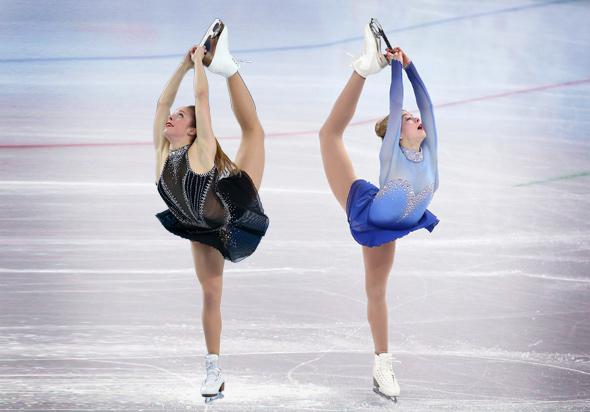Figure skating got off to an early start at the Sochi Olympics with the newfangled team competition, an innovation that gave NBC the opportunity to get an early start hawking the narratives of Gracie Gold and Ashley Wagner. America’s two leading female figure skaters won’t take to the ice again until next Wednesday, when in all likelihood neither will medal. NBC (not to mention Sports Illustrated, which put Gracie Gold on a recent cover) has not let this niggling detail interfere with its mythmaking. There is one American figure skater who looks like a blonder Disney Princess and whose name sounds like destiny. There is another who, with her slash of red lipstick, looks like an imperious evil queen and knows how to work a ponytail for maximum swag. The fact that both will have to do exceptionally well to place even fourth is not going to stop NBC from selling Gold and Wagner as those evergreen stereotypes, the golden girl and the ice princess, whether they embody those tired tropes or not.
Ice skaters swoop around on an extremely hard surface mounted on razor-sharp blades that they slam into the ground to launch themselves high into the air. And yet despite being nearly indestructible, both physically and mentally, they are presented as delicate flowers, girls in tights and skirts judged upon their artistry, whose raw physical ability needs to be corralled and contained. (Watch the recent Tonya Harding-Nancy Kerrigan documentary The Price of Gold if you want to hear athletes’ athleticism discussed with a sneer.)
The 18-year-old Gold, who won the recent U.S. Championships and who placed second in the long program in the Olympics team competition, is the sort of delicate flower who will rip your hand to shreds. She looks like Grace Kelly but often sounds like Tracy Flick, which I mean as a compliment. The media has been keen to revel not only in her name—never have headline writers looked a gift horse so directly in the mouth—but other cutesy details: She has a twin sister, is a big fan of Taylor Swift and sushi, and was once obsessed with the color pink.
Gold may have her girly bona fides in order, but she’s tougher than all that. She loves to jump and skate fast, and is better technically than artistically. She describes herself as being “a powerful skater and … a powerful person.” She’s reading one of Phil Jackson’s books, and when she appeared on The Tonight Show she ably silenced the house band when she needed to focus on her juggling. Her assessment of Yulia Lipnitskaya, the bendy 15-year-old Russian who wowed everyone at the team competition, was spiky and apt: “She’s completely unfazed. She has no spine, but she has iron in her bones.”
If Gold is getting the golden-girl edit, Wagner’s all ice queen. The 22-year-old, already immortalized for her high-level stank face over the weekend, narrowly missed the Vancouver Olympics and narrowly made the Sochi Games. Wagner has been one of the country’s best skaters over a period of years, winning nationals twice in a row, but she all but combusted at the most recent nationals, falling twice and coming in fourth. She was awarded a spot on the Olympic team over the third-place winner, Mirai Nagasu, who is Asian-American, a move that some thought was racist, but was more likely just cutthroat.
During the team competition—Wagner skated the short program, Gold the long—Wagner had something to prove. She came onto the ice, her nostrils all but flaring to the ceiling, skating to Pink Floyd’s “Shine On You Crazy Diamond,” and performed a routine that she thinks shows off her “sexy” and “edgy” vibe. Finished, mistake-free, and feeling vindicated, she did a shoulder shimmy and a hair toss—and then pulled that face.
Wagner knows she’s sassy and revels in it. If you have an hour to get to know her, I highly suggest this two-part interview with the Skating Lesson, in which she describes a bad fall as getting her “mentally worried about my future children” and admits to the existence of “diva Ashley.” (The Skating Lesson more generally is wonderfully bitchy and insightful and recently described Gold and Wagner as being “in no danger of winning the gold medal.”) But she also tearfully mouthed “I’m sorry” to her demanding mother after tanking at nationals and is the sort of sheltered high-performance athlete who thinks learning to do yoga and seeing her friends occasionally constitutes work-life balance.
In women’s figure skating, a skater’s “narrative” doesn’t just affect ratings, endorsement deals, and the audience’s tear ducts. It affects scores. Figure skating is a judged sport. Though steps have been taken to make that judging more objective, it is still full of subjective elements, with points left to the judges’ discretion. What a skater wears, how she looks, and her attitude all matter. Wagner’s ponytail flip might have affected her scores. Or the judges could have gotten the sense after the U.S. nationals that it’s Gracie Gold’s time. Or it could be that she didn’t nail her first jumping pass quite as cleanly as she thought. Or some combination of all three. Stories of ice princesses and golden girls may be overly simplistic, but those of us watching at home aren’t the only ones gobbling them up.
